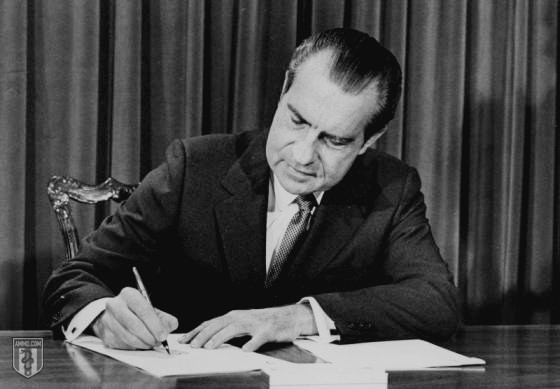 By Brian Miller
By Brian Miller
Information has taken on a whole new meaning in the digital age, a time when sensitive data is either too easily accessible or not accessible enough. This issue of access to information encompasses fundamental human rights – specifically the freedom of speech as well as the right to privacy. Because it’s a primary means of maintaining transparency and accountability within government policies and decision-making in both the United States and around the globe, information is more valuable than ever to both government agencies and our individual lives.
This guide takes an in-depth look at FOIA history and the importance of exercising your right to know.
International Right to Know Day: September 28th
September 28th marks International Right to Know Day. What began as a meeting between freedom of information organizations from 15 countries in 2002, has expanded to a global observance supported by more than 200 organizations worldwide. Each year, International Right to Know Day seeks to make people aware of the distinct rights they have to access government information that is essential to “open, democratic societies in which there is full citizen empowerment and participation in government.” Within the United States, those rights come in the form of the Freedom of Information Act, or FOIA.
Freedom of Information Act
July 2016, marked not only FOIA’s golden 50-year anniversary, a milestone in Americans’ rights to scrutinize government agency records, but also the FOIA Improvement Act of 2016. Together, they remind us that FOIA’s guarantee of access to information was not easily acquired – nor was it a legally binding right. In fact, FOIA’s very creation was highly controversial. And since it has passed, its implementation and execution have continued to present challenges of their own.
1789 Housekeeping Statute
For more than 175 years, the United States relied on what was known as the 1789 Housekeeping Statute. As the U.S. Constitution does not specify policy or procedure for information sharing either among federal bodies or with the public, Congress’ 1789 statute authorized heads of departments to maintain records and to determine how those records would be used.
Although the legislation was considered simply a “housekeeping” measure for a growing nation, opponents of free access even today continue to invoke it in arguments to withhold information – even though a one-line 1959 amendment to the statute specifically states, “This section does not authorize withholding information from the public or limiting the availability of records to the public.”
Administrative Procedure Act of 1946
As the growing nation continued to create agencies and departments, President Franklin Delano Roosevelt saw the need to once again establish some additional housekeeping rules through the Administrative Procedure Act. According to the act, federal agencies had to maintain records and make them “available to public inspection” – except for “information held confidential for good cause.” Fraught with loopholes, the act gave more cause to withhold information than to share it. However, it did require that agencies:
- Establish offices where the public could “secure information or make submittals or requests.”
- Publish formal and informal procedures for information sharing.
- Make available “instructions as to the scope and contents of all papers, reports, or examinations.”
FOIA Reaction to Cold War Secrecy
Post-World War II, however, conflict assumed new dimensions in the Cold War. Governmental secrecy increasingly frustrated journalists and the public alike. Open demand for information grew, spurred on by Harold Cross’ 1953 publication of The People’s Right To Know and ensuing congressional initiatives led by California’s Democratic Representative John Moss.
On July 4, 1966, President Lyndon B. Johnson issued a signing statement to edify Congress’ fresh, new Freedom of Information Act with limitations. Although his statement asserted that “a democracy works best when the people have all the information that the security of the nation will provide,” it focused heavily on the fact that “the welfare of the nation or the rights of individuals may require that some documents not be made available.” While reluctantly conceding the act as necessary, Johnson removed many of the act’s teeth exception by exemption. Even so, for the first time, a law had been written with the sole purpose of ensuring public access to federal agency records.
Effects of Nixon Administration and Watergate
 Less than a decade later, perhaps one of the greatest positives that resulted from the scandal of Watergate and the Nixon administration’s abuse of power was FOIA’s strengthening. As more and more details of secretive, inappropriate activities involving the Federal Bureau of Investigation, Central Intelligence Agency and Internal Revenue Service came to light, public distrust and demand for accurate information grew.
Less than a decade later, perhaps one of the greatest positives that resulted from the scandal of Watergate and the Nixon administration’s abuse of power was FOIA’s strengthening. As more and more details of secretive, inappropriate activities involving the Federal Bureau of Investigation, Central Intelligence Agency and Internal Revenue Service came to light, public distrust and demand for accurate information grew.
In answer, Congress drafted the FOIA Amendments of 1974 – not only passing them, but also overriding a presidential veto from then-President Gerald Ford. The amendments became law on November 21, 1974, establishing:
- Acceptable guidelines and response timelines for information requests.
- More specific conditions for denials.
- Accountability for denials of requests.
- Administrative and legal fee guidance.
Government in the Sunshine Act of 1976
Two years later, as acknowledgement that most decision-making occurs behind closed doors, the Government in the Sunshine Act of 1976 sought to open them. Under the act, any meeting involving a quorum of board or commission members must be placed on the Federal Register seven days in advance and must allow interested members of the public to attend. However, it, too, contains exemptions and issues of interpretation that continue to obscure the intended transparency, especially for journalists and the media, who often are the first to inform the public of new or pending changes within our government.
National Defense and Executive Order 12356
By the 1980s, executive orders concerning the classification and handling of sensitive intelligence information were nothing new. Presidents Truman, Eisenhower, Nixon and Carter had all issued ones of their own. However, President Ronald Reagan’s Executive Order 12356, effective August 1, 1982, gave classifying authorities considerable leeway in being able to withhold information on the basis of preserving national security. Among many other exemptions, of particular note were instructions that:
- “If there is reasonable doubt about the need to classify information, it shall be safeguarded as if it were classified.”
- “If there is reasonable doubt about the appropriate level of classification, it shall be safeguarded at the higher level of classification.”
- “Information may be classified or reclassified after an agency has received a request for it.”
War on Drugs and Anti-Drug Abuse Act of 1986
Along with concerns about national security, the War on Drugs marked the 1980s. While addressing an America struggling with drug addiction by tightening mandatory sentencing guidelines, Congress’ Anti-Drug Abuse Act of 1986 under the Reagan administration also amended FOIA. Its Subtitle N broadened the exemptions for access to law enforcement records, especially information regarding informants or active investigations. It also categorized FOIA requests and fee structures by purpose – commercial, scholarly or in public interest – making fee waivers much more difficult to obtain.
Clinton Administration Executive Order 12958
In an effort to simplify the FOIA process, President William Jefferson Clinton issued Executive Order 12958 in 1995, setting forth criteria that would allow hundreds of thousands of documents that were more than 25 years old and of “permanent historical value” to be declassified. Setting a new tone, the order stated, “If there is significant doubt about the need to classify information, it shall not be classified.”
Electronic Freedom of Information Act Amendments of 1996
With government agencies backlogged with requests for information and the World Wide Web a rapidly expanding reality, President Clinton also signed into law the Electronic Freedom of Information Act Amendments of 1996. The amendments sought to bring federal agencies into the electronic age and make information readily accessible. It mandated sharing of federal agency information through webpages and reading rooms, but doubled agency response times from 10 days to 20. The hope was that accessibility to government-provided data from any location through the Internet would substantially both reduce the number of requests for information and increase transparency.
Limiting Access Post-September 11, 2001
 The threats that September 11, 2001, and the ensuing conflict presented to national security altered – and in some cases even reversed – prior initiatives to make information more accessible. Policymakers viewed the sheer volume of information as well as users on the Internet and their global reach far beyond U.S. domestic control as a vulnerability.
The threats that September 11, 2001, and the ensuing conflict presented to national security altered – and in some cases even reversed – prior initiatives to make information more accessible. Policymakers viewed the sheer volume of information as well as users on the Internet and their global reach far beyond U.S. domestic control as a vulnerability.
Under President George W. Bush’s administration, a number of congressional actions coupled with executive orders once again pushed the FOIA pendulum to more restrictive limits:
- Dated November 5, 2001, Executive Order 13233 restricted access to presidential records, reduced the Archivist’s role and earned open condemnation from the American Library Association. The order stated that a president’s constitutional privileges “subsume” privileges for records reflecting “military, diplomatic, or national security secrets . . . communications of the President or his advisors . . . legal advice or legal work . . . and the deliberative processes of the President or his advisors.” Of note, President George W. Bush issued more than 50 executive orders in 2001 alone.
- On December 19, 2002, Congress passed the Intelligence Authorization Act for Fiscal Year 2003, adding a section entitled “Prohibition on Compliance with Requests for Information Submitted by Foreign Governments” to block foreign access to intelligence community agency records.
- In 2003, President Bush issued Executive Order 13292, amending former President Clinton’s earlier Executive Order 12958, regarding classified national security information. Bush’s order reverted to the precedent to classify when in doubt and made declassification both more difficult and a mission of low priority.
OPEN Government Act of 2007
As 2007 drew to a close, Congress passed the OPEN Government Act of 2007, and President George W. Bush signed it into law on December 31st. The first sentence identified it as an act “to promote accessibility, accountability, and openness in Government by strengthening section 552 of title 5, United States Code (commonly referred to as the Freedom of Information Act).” It acknowledged that “disclosure, not secrecy, is the dominant objective” and that “in practice, the Freedom of Information Act has not always lived up to the ideals of that Act.” In that spirit, the act:
- Protected the fee status for news media by defining representatives of the news media and journalists.
- Placed responsibility for attorney fees and litigation costs an agency incurs from FOIA judgments against it on the agency.
- Prohibited agencies from assessing certain fees if they failed to comply with FOIA deadlines.
- Established disciplinary actions for “arbitrary and capricious rejections of requests” and instituted a Special Counsel to submit an annual report to Congress.
- Amended response time frames to allow for clarifications of requests and a 10-day initial grace period for receipt of the request.
- Directed agencies to establish individualized tracking systems for requests.
- Instituted agency reporting requirements for FOIA requests.
- Included government information held by private entities, like contractors.
- Established the Office of Government Information Services within the National Archives and Records Administration to review policies, monitor compliance, recommend changes to FOIA and mediate disputes.
- Mandated that each agency designate a Chief FOIA Officer.
- Directed the Office of Personnel Management to ensure agencies had career paths for FOIA-dedicated individuals.
- Specified that deleted material must include documentation for applicable exemptions.
Obama Administration Executive Order 13489
 One day after his inauguration, President Barack Obama issued his first Executive Order – EO-13489 – to revoke President Bush’s EO-13233. While former President Bush had invoked extended executive privilege, including heirs and designees, to block access to White House records, the Obama order returned to earlier conventions, limiting executive privileges only to living presidents, not their heirs or designees. The new order also discarded EO-13233’s provision for vice presidential executive privilege. Most crucial, however, was the fact that the new order re-instituted the role of the Archivist of the United States as the arbiter of disclosure versus executive privilege.
One day after his inauguration, President Barack Obama issued his first Executive Order – EO-13489 – to revoke President Bush’s EO-13233. While former President Bush had invoked extended executive privilege, including heirs and designees, to block access to White House records, the Obama order returned to earlier conventions, limiting executive privileges only to living presidents, not their heirs or designees. The new order also discarded EO-13233’s provision for vice presidential executive privilege. Most crucial, however, was the fact that the new order re-instituted the role of the Archivist of the United States as the arbiter of disclosure versus executive privilege.
Obama Administration Executive Order 13526
Before the year had closed on his first year in the presidency, President Obama issued his own executive order regarding classified national security information. Executive Order 13526 replaced both President Clinton’s EO-12958 and President Bush’s EO-13292.
While it directed, “If there is significant doubt about the appropriate level of classification, it shall be classified at the lower level,” and stated, “No information may remain classified indefinitely.” It also maintained, “An original classification authority may extend the duration of classification up to 25 years from the date of origin of the document, change the level of classification, or reclassify specific information.”
Reducing Over-Classification Act
Less than a year later, in October of 2010, Congress passed and President Obama signed the bipartisan Reducing Over-Classification Act. Analysis of the intelligence shortcomings that led to September 11th focused on a lack of information sharing, much of it due to over-classification and the perception of information as proprietary. In fact, Section 5, “Intelligence Information Sharing,” contains a section dedicated to the “Creation of Unclassified Intelligence Products as Appropriate for State, Local, Tribal and Private Sector Stakeholders.”
FOIA Improvement Act of 2016
On June 30, 2016, President Obama signed the FOIA Improvement Act of 2016, which once again sought to modernize the process of releasing information, reduce backlogs, and establish uniform points of contact to manage requests and the sometimes inevitable denials. While much of the document remained the same, the most significant changes demonstrate the complexities of public disclosure:
- Agencies must make documents and information available to requesters in electronic formats.
- Information requested and disclosed at least three times must be made publicly available in electronic format on an agency’s website.
- Agencies are not allowed to charge fees for services if they miss applicable deadlines.
- Agencies must disclose information unless disclosure might harm a protected interest, such as national security.
- Agencies can release requested records created at least 25 years prior to a release request.
- Requesters denied access can seek out “dispute resolution services from the FOIA Public Liaison of the agency or the Office of Government Information Services.”
- Expanded roles for Chief FOIA Officers at each agency and a new Chief FOIA Officers Counsel will increase compliance and efficiency.
- A new, consolidated online FOIA website portal will provide one contact point for all public FOIA requests to all federal agencies.
FOIA Today
 Today, the Freedom of Information Act allows any person to request information from any federal agency for any reason. Whether you’re a U.S. citizen or a foreign national, a student or a university, a corporation or an organization – if an agency created or obtained a record and still retains possession of it, you can request it. In fact, in 1989, the Supreme Court ruled that neither the identity of a FOIA requester nor the “purposes for which the request for information is made” can be taken into consideration in determining what should be released under the Act; law denies FOIA access only to fugitives from justice and foreign governments.
Today, the Freedom of Information Act allows any person to request information from any federal agency for any reason. Whether you’re a U.S. citizen or a foreign national, a student or a university, a corporation or an organization – if an agency created or obtained a record and still retains possession of it, you can request it. In fact, in 1989, the Supreme Court ruled that neither the identity of a FOIA requester nor the “purposes for which the request for information is made” can be taken into consideration in determining what should be released under the Act; law denies FOIA access only to fugitives from justice and foreign governments.
FOIA Request Tips and Pointers
That said, some requests are granted more readily than others. And despite modernization and best efforts, backlogs in excess of accepted response times continue to plague every agency. Before you submit your FOIA request, consider that:
- As agencies continue to expand their websites with frequently requested data, the information you’re seeking may already be readily available. Too, agencies must make certain records – final court opinions, unpublished policy statements and staff manuals, for example – available through the Federal Register.
- FOIA does not apply to the president, Congress, members of Congress, the federal courts or judiciary, state or local governments, or private individuals or organizations.
- Many agencies maintain electronic records, and you may be able to download charts or tables – Excel files, for example – for analysis or request them via email without submitting a formal FOIA request.
- Simpler, specific record requests are processed more quickly than large, complex ones. You might want to submit several smaller requests by priority.
- You must identify exactly which records you want and the agency who has them. Agencies won’t answer general questions, create or re-create new records, or perform analysis for you. They won’t acquire records from private sources for you, either. If you apply to the wrong agency, they will forward your request, but it will delay the process by up to 10 days, sometimes more.
- Fees may be associated with fulfillment of your request.
- Response times are not fixed. Your response clock may be stopped and restarted due to unusual circumstances or needs for clarification, so plan accordingly.
FOIA’s 9 Exemptions and 3 Exclusions
Even if you accurately identify records, FOIA preserves nine exemptions from disclosure that may result in the denial of your request if the information is:
- Classified due to national security. For many intelligence community records, even the fact that a document exists is classified information.
- Related solely to internal personnel rules and practices.
- Exempt or prohibited under other laws.
- Confidential or privileged business information, such as trade secrets or privileged commercial or financial information.
- Inter- or intra-agency communication, such as records involving attorney-client, attorney-work or deliberative process privileges.
- A matter of personal privacy. Even if records are released, names of individuals may be redacted, or blacked out, to preserve personal privacy.
- Compiled for law enforcement purposes. Requests are denied if a record’s release could interfere with enforcement proceedings or impartial adjudication, invade personal privacy, identify a confidential source, disclose law enforcement techniques or endanger an individual’s safety.
- Concerning the supervision of financial institutions.
- Geological information on wells.
Law enforcement records are especially sensitive. Records are excluded if their release could compromise an active investigation or prematurely reveal the identity of a confidential source. A third exclusion protects classified Federal Bureau of Investigation records associated with foreign intelligence, counterintelligence or international terrorism.
Submitting Your FOIA Request
With each agency maintaining its own policies, procedures and fees, the FOIA process may at first seem daunting. But overarching all of the technicalities are basic mandates set forth through FOIA. In general:
- You do have the right to request records from any federal agency for any reason.
- Each agency must have a FOIA office and regulations governing procedures for submitting requests, fee schedules, fee waiver criteria and administrative appeal procedures.
- You should receive an acknowledgement of your request that indicates whether records were located. If they are not enclosed, the acknowledgement should specify how and when you will receive them, list any associated fees and include an explanation for any denials of your request.
- Your request can be expedited if lack of expedited handling could jeopardize someone’s safety or deprive someone of due process rights.
- If your request is denied, you have the right to appeal the decision in accordance with the agency’s policy and procedures.
- The Office of Government Information Services has mediation services that FOIA requesters can use to resolve disputes with agencies without resorting to litigation.
FOIA has come a long way from its initial attempts to make information available to the public. Each day, agencies add hundreds of thousands of records into electronic databases, expanding agency websites and electronic reading rooms often exponentially. At no other time in history has information been so readily available and accessible to so many ordinary people.
But while public information is at an all-time high, people fighting for more access is also on the rise. Trump’s first year in office saw a 26-percent increase in FOIA lawsuits since the previous year – a reminder of the importance of this act. The key to unlocking all this information comes through knowing the law and exercising your right to know.
This article was sourced from Ammo.com
Be Free and Independent! Get a free issue of Counter Markets today.

Be the first to comment on "Right to Know: A Historical Guide to the Freedom of Information Act (FOIA)"